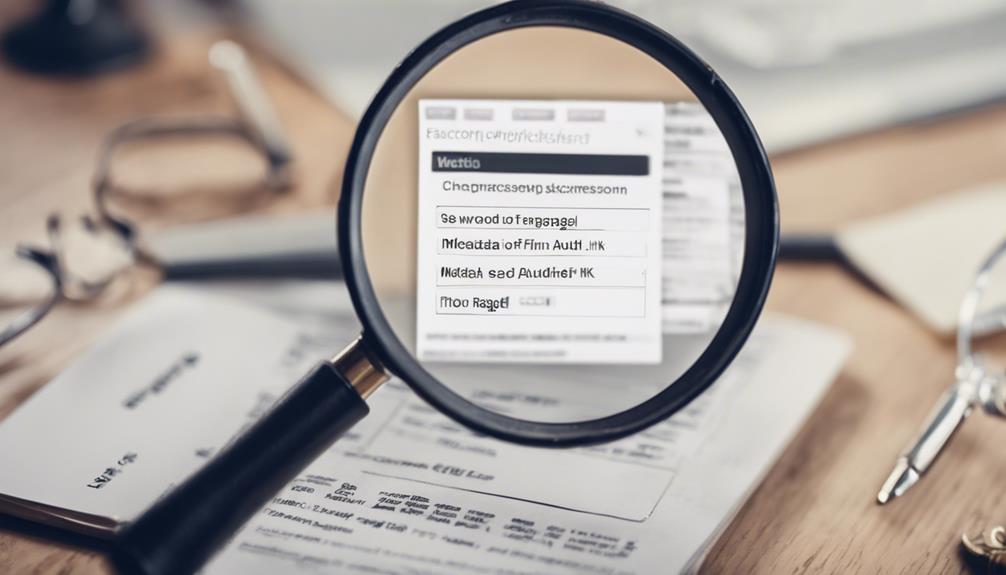Conducting a thorough SEO audit is vital for enhancing website performance and elevating search engine rankings. Evaluating on-page elements like content, structure, and HTML source code uncovers critical issues such as duplicate content and slow loading speeds that impact both search visibility and user experience. Ensuring efficient crawling and indexing, optimizing meta tags and structured data, auditing content quality and relevance, and focusing on internal links and navigation are key components of a successful SEO audit checklist. Understanding these fundamental principles lays a solid foundation for improving website optimization and organic traffic growth.
Key Takeaways
- Evaluate website optimization for search engines through on-page SEO audit.
- Uncover issues like duplicate content and slow page speed for improvement.
- Regularly check for crawl errors and optimize crawling and indexing.
- Enhance search visibility with meta tags and structured data.
- Assess content quality, relevance, and optimization for better SEO performance.
Basics

When delving into the fundamental aspects of SEO auditing, one must first grasp the essential foundation of website optimization for search engines. An on-page SEO audit is vital in evaluating how well a website is optimized for search engines like Google. This process involves analyzing the content, structure, and HTML source code of a site to identify any issues that may be hindering its visibility in organic search results.
Conducting a thorough SEO audit is important because it helps uncover common issues such as duplicate content, broken links, missing meta tags, and slow page speed that can negatively impact a site's search rankings and user experience. By addressing these basic SEO audit components, website owners can improve their site's organic search performance and make sure that it is properly optimized to attract more traffic from search engines. It is essential for all websites, especially business sites, to regularly conduct SEO audits to stay competitive in the online landscape.
Crawling & Indexing
Efficient website crawling and indexing are vital components of successful search engine optimization strategies, guaranteeing that search engines can properly access and organize web content for optimal visibility. Crawling involves search engines visiting and analyzing website pages for indexing purposes. Indexing, on the other hand, refers to search engines storing and organizing web pages in their database for retrieval in search results. Utilizing tools like robots.txt can help control which pages search engine crawlers can access, while XML sitemaps assist search engines in discovering and indexing pages more efficiently.
Regularly checking for crawl errors in Google Search Console is essential as it can help identify and resolve any indexing issues that may arise. By analyzing crawl errors and addressing them promptly, website owners can make sure that their content is properly indexed and visible to users searching on search engines. This proactive approach to managing crawling and indexing processes can greatly improve a website's overall SEO performance.
Meta and Structured Data

Meta tags and structured data are essential elements in optimizing a website for improved search visibility and user experience. Meta tags, such as title and description, are critical for enhancing click-through rates and increasing search visibility. On the other hand, structured data markup, including schema markup, helps search engines better understand website content, potentially leading to rich snippets in search results. By properly optimizing meta tags and structured data, websites can not only attract more organic traffic but also provide a more enhanced user experience. The utilization of schema markup for structured data can have a substantial impact on organic click-through rates and boost search engine rankings. Websites that implement structured data effectively stand a better chance of standing out in search results and attracting more qualified traffic, ultimately contributing to improved SEO performance.
Content
To optimize a website for improved search visibility and user experience, thorough evaluation and enhancement of on-page content are fundamental components of a successful SEO strategy. Conducting a content audit is essential in evaluating the quality, relevance, and optimization of on-page content to enhance SEO performance. This involves reviewing content depth, uniqueness, and user engagement metrics to make sure that the material aligns with the target audience's needs. Additionally, identifying and rectifying issues such as thin content, duplicate content, and opportunities for keyword optimization are important objectives of a content audit. By optimizing meta tags, headings, and internal linking structures, websites can improve content visibility and search rankings. Regularly updating and revamping content based on performance data and SEO best practices is necessary for maintaining and enhancing search visibility over time. By focusing on these aspects, websites can create a more engaging and optimized on-page content strategy that aligns with both user needs and search engine requirements.
Links & Navigation

A well-organized system of internal links plays a pivotal role in distributing PageRank effectively and improving website navigation. Internal links not only enhance SEO performance by assisting search engines in discovering and indexing content but also contribute to a better user experience by guiding visitors to relevant information within the site. Proper website navigation is essential for both users and search engines to easily navigate through the site. Broken links can harm SEO efforts and frustrate users, underscoring the importance of promptly fixing any broken links that are discovered.
Anchor text optimization in internal links can further boost keyword relevance, aiding in better search engine visibility. Navigation menus should be clear, concise, and user-friendly to make sure visitors can easily find the information they are looking for. By optimizing internal links and ensuring smooth website navigation, a website can enhance both its user experience and SEO performance simultaneously.
Images
How can optimizing images contribute to enhancing website performance and user experience? Images play an essential role in engaging site visitors, but they can also impact site speed and SEO. By using descriptive filenames and alt text, websites can improve their SEO for images, making them more discoverable by search engines. Additionally, compressing images helps reduce page load time, enhancing overall performance and user experience. Implementing image sitemaps further assists search engines in indexing and ranking website images effectively. To guarantee images display correctly across various devices and screen sizes, utilizing responsive images is vital. By following these image optimization practices, websites can not only boost their SEO but also create a smoother and more visually appealing user experience for visitors. Remember, optimizing images goes beyond just their visual appeal; it influences site speed, search engine visibility, and overall user satisfaction.
Frequently Asked Questions
What Is Included in an SEO Audit?
An SEO audit encompasses a comprehensive evaluation of a website's performance, user experience, and search engine visibility. It involves evaluating indexing issues, duplicate content, technical errors, on-page elements optimization, mobile-friendliness, page speed, internal linking, organic traffic data, competitor analysis, keyword opportunities, and backlink prospecting.
How to Do SEO Audit Step by Step?
To conduct a thorough SEO audit step by step, start with a detailed site crawl for technical issues and optimize on-page elements. Address indexing and site speed concerns, implement best practices like keyword optimization, internal linking, and content improvements for better search performance.
What Should Be Included in a Technical SEO Audit?
A technical SEO audit encompasses an evaluation of URL structure, canonicalization, JavaScript rendering, meta data, XML sitemaps, internal linking, mobile-friendliness, page speed, indexability, duplicate content, and sitemap optimization. These elements are crucial for search engine visibility and user experience.
How Do I Know if My Website Needs an SEO Audit?
To determine if your website needs an SEO audit, monitor for declining organic traffic or rankings, Google Search Console penalties, or technical issues through site crawl audits. Regularly assess KPIs like bounce rate and stay updated on SEO best practices to remain competitive.
